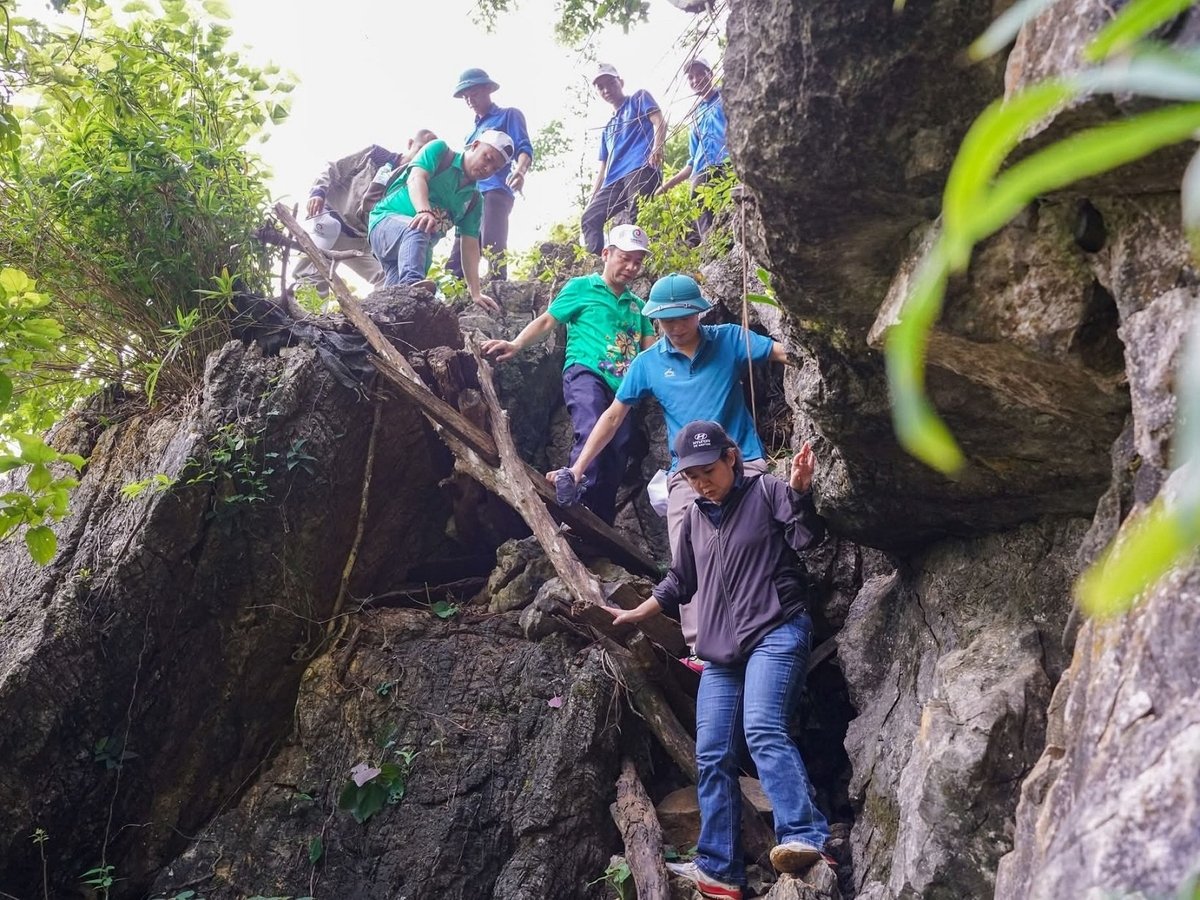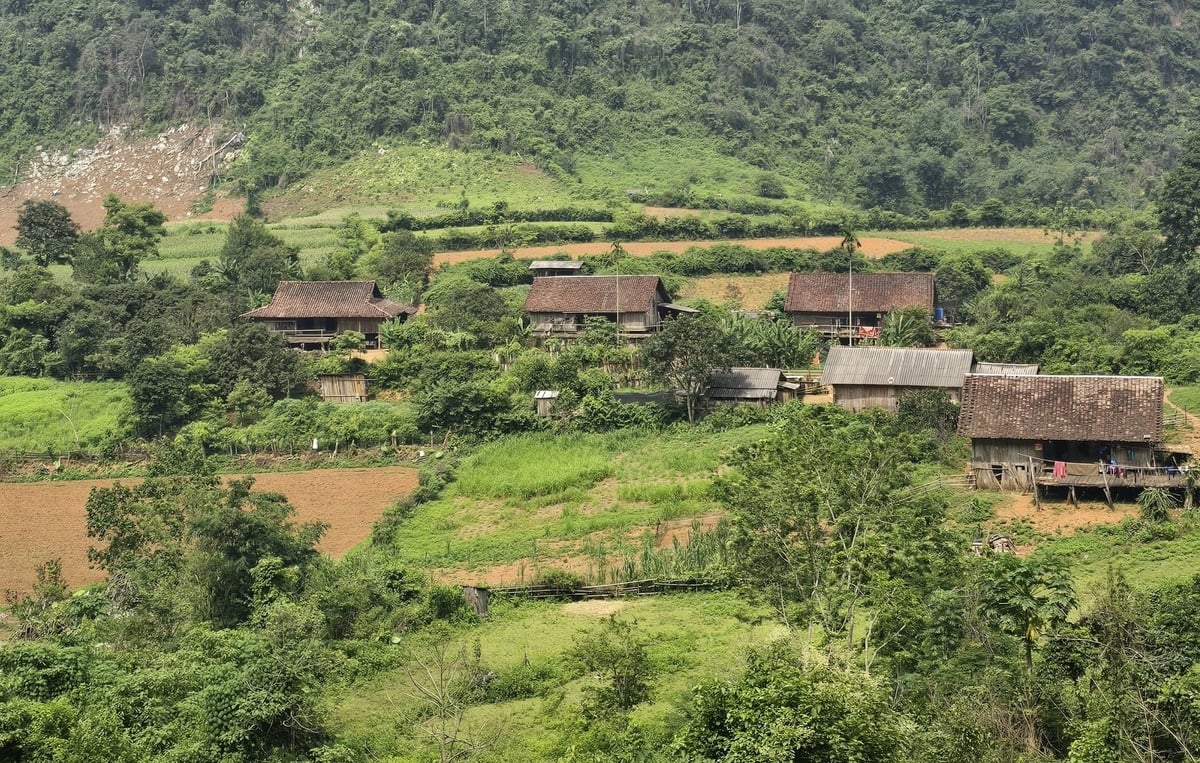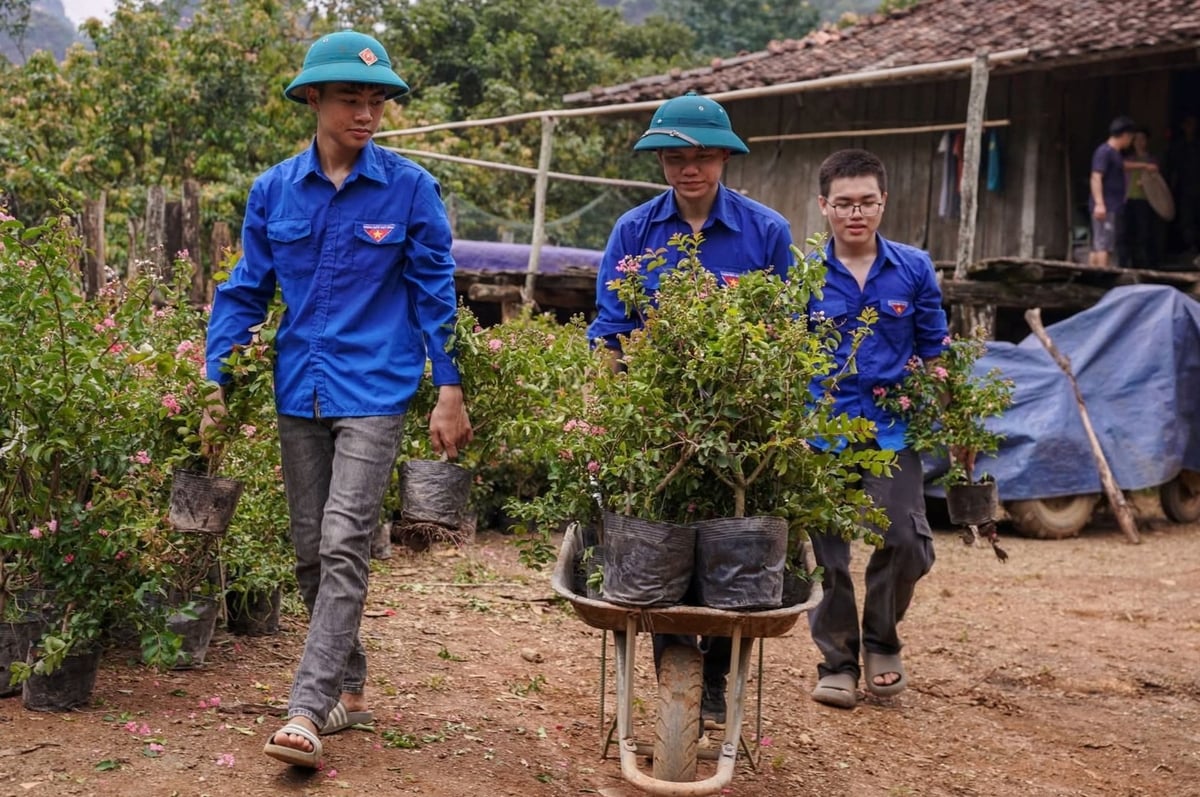December 30, 2025 | 14:04 GMT +7
December 30, 2025 | 14:04 GMT +7
Hotline: 0913.378.918
December 30, 2025 | 14:04 GMT +7
Hotline: 0913.378.918
Leaving the center of Cai Kinh commune, the journey to Lan Nong is far from simple. After nearly two hours crossing dense forests and rugged, treacherous limestone mountains, we finally reached a small hamlet hidden deep within the vast wilderness.
There was no phone signal to guide us, no signposts, only directions from local villagers and the forest birdsong that seemed to lead the way.
Lan Nong currently has 13 households with nearly 70 residents, all belonging to the Nung ethnic group. Without irrigation water, the land can only support the cultivation of corn and peanuts. Because of these challenges, as many as 10 households fall under the poverty category.

From the center of Cai Kinh commune to Lan Nong, many sections require crossing rugged limestone mountains. Photo: Pham Huong.
Completely isolated from the national power grid, the residents here still live in traditional wooden stilt houses, relying on light from oil lamps, candles, or small solar panels just enough to illuminate their evening meals and brighten the stories shared around the hearth.
No honking cars, no dust, no glaring screens, Lan Nong appears like a parallel world completely separated from urbanization. Here, the sounds of roosters crowing, birds singing, and children playing create a unique soundtrack of slow and peaceful life.
Although there are no phones or internet, the people of Lan Nong maintain a way of connecting that seems to have faded into the past through calling out to each other across the village, attending community meetings, or simply chatting around the fire each night.
"No electricity, no signal, it can be inconvenient, but we’re used to it. Living close together, everyone is as close as family. At night, just sitting together around the firewood stove is enough to feel warm inside," smiled Mrs. Le Thi Len, a longtime resident of the hamlet.
What might seem like deprivation is actually the foundation for a promising future: Lan Nong is becoming a Net Zero village. Unlike many localities that must invest heavily in green technologies to reduce emissions, Lan Nong has reached Net Zero at its core from the start.
Here, residents do not litter or burn waste indiscriminately. Organic waste is reused as fertilizer and fuel. Clean water is sourced from streams flowing out of limestone caves, and farming is done without chemicals. Every daily action follows natural laws, simple yet deeply responsible toward the environment.

A corner of Lan Nong hamlet - a place that is almost emission-free. Photo: Hoang Nghia.
Because the area has not been concrete-paved, the landscape here still preserves the pristine beauty of ancient forests, rocky mountains, and native vegetation, which is an invaluable advantage in the trend toward sustainable tourism development.
Lan Nong is currently located within the UNESCO Lang Son Global Geopark, a place that converges rich geological, cultural, and scenic values. With its isolated location, distinct Nung cultural identity, and untouched natural environment, this area possesses all the essential elements to become a shining example of community-based tourism, provided the right approach is taken.
Mr. Ha Vu Khoi, Chairman of the People’s Committee of Cai Kinh commune, shared: "Our goal is to build a gentle tourism model that does not disrupt the landscape or erode the local soul. The commune is studying ways to collaborate with experts to implement small but effective solutions such as landscape restoration, ecological toilets, homestays using traditional stilt houses, and installing mini solar power systems..."
Initial activities to develop Lan Nong into a Net Zero village have recently been launched. Local authorities, Lang Son functional departments, and residents have planted over 1,500 rose myrtle trees along village paths and family fences.
At the same time, they have conducted thorough cleaning of stilt house areas, collected waste, tidied yards, organized cultural and culinary exchanges, guided residents on preserving stilt house architecture, and made environmentally friendly trash bins. These are the soft resources that invite visitors not only to see but also to understand, feel, and appreciate.

As one of the two oldest residents in Lan Nong at 88 years old, Mrs. Trieu Thi So said she always reminds her children and grandchildren to protect the forest and preserve the environment so that the village remains fresh and peaceful. Photo: Hoang Nghia.
According to Ms. Pham Thi Huong, Head of the Lang Son Geopark Management Department (Lang Son Province Investment, Trade, and Tourism Promotion Center), there are still many obstacles in the process of realizing Lan Nong as a Net Zero village. Among these challenges are slippery access roads during the rainy season and the lack of phone signal, which complicate coordination, communication, and promotion efforts. Local residents are not yet familiar with tourism, so time is needed to shift mindsets and habits.
Therefore, in the coming period, it is necessary to simultaneously implement many factors such as improving non-concrete trails, investing in minimalist infrastructure, and training residents in skills ranging from welcoming guests and preparing hygienic food to storytelling about ethnic culture.
"The most important thing is to preserve the village’s soul. A stilt house can become a homestay, a countryside meal can be an experience, and an old forest can become an attractive tourist spot but the identity must not be diluted," emphasized Ms. Huong.
Lan Nong’s near-complete existence outside the modern cycle is rare in today’s development context. This very fact makes it a potential symbol of green, sustainable, and humane development.

The young in Cai Kinh commune support planting rose myrtle trees, building Lan Nong into a Net Zero Village in the future. Photo: Pham Huong.
But to preserve that pristine nature, every step must be taken with caution. If tourism development comes at the cost of the environment, losing simplicity, friendliness, and community bonds. Then, it will all be nothing but a flashy shell.
"Tourism is just a means. The goal is for villagers to live better, more prosperous lives while still preserving their homes, their mindset, and a lifestyle that is friendly to the environment and deeply connected to protecting the green forest. Visitors come and go, but this village must remain as it has always been," affirmed Mr. Khoi.
If done properly and systematically, Lan Nong will not only escape poverty but also become a model for many other mountainous localities in combining conservation, tourism, and economic development. A model not based on concrete or high technology, but on inherent values: natural landscapes, indigenous culture, and community spirit.
Lan Nong can be a Net Zero village not just in theory but as a vivid living example of a sustainable future, where humans and nature coexist in harmony and mutual respect.
Amid the vast forests of Lang Son, Lan Nong is not just a destination but a story that needs to be continued with responsibility, with heart, and with footsteps that do not harm the Earth.

Mr. Ha Vu Khoi, Chairman of the People’s Committee of Cai Kinh commune, presented gifts and encouraged the people of Lan Nong to join hands in building the Net Zero Village. Photo: Hoang Nghia.
Due to the difficult access to the center of Cai Kinh commune, the people of Lan Nong contributed money and labor to build a dirt road over 5 kilometers long to the center of Van Linh commune, making travel, shopping, and goods exchange much more convenient.
Translated by Kieu Chi
/2025/12/26/0703-3-204813_117.jpg)
(VAN) Transparency in information and listening to local people have helped address ground clearance bottlenecks and build social consensus, thereby accelerating the progress of the JICA3 irrigation project.
/2025/12/27/0609-3-233846_327.jpg)
(VAN) The JICA3 project is expected to become a 'water shield,' helping control saltwater intrusion, proactively secure water resources, protect livelihoods, and promote sustainable development in coastal areas.
/2025/12/26/5654-3-164509_655.jpg)
(VAN) As Viet Nam makes strong commitments toward achieving net-zero emissions, controlling and reducing methane emissions in livestock production is increasingly becoming a mandatory requirement.

(VAN) 'People, Primates, Plants: Co-managing Biodiversity and Improving Livelihoods in Vietnam' (the PPP Project) is an international initiative implemented in Vietnam by BGCI, CEGORN, and ICRAF/World Agroforestry.

(VAN) Dak Nong established a risk-level zoning map for coffee, built a digital data platform for the sector, and promoted certified production in line with EUDR.
/2025/12/25/2709-1-211551_295.jpg)
(VAN) In response to the U.S. Marine Mammal Protection Act (MMPA), Gia Lai province is implementing many solutions to protect marine mammals and develop sustainable, responsible fisheries.

(VAN) In modern livestock farming, vaccination and proactive disease prevention keep pigs healthy, secure productivity, and reduce dependence on antibiotics.